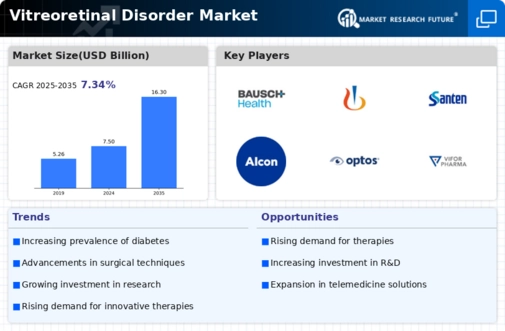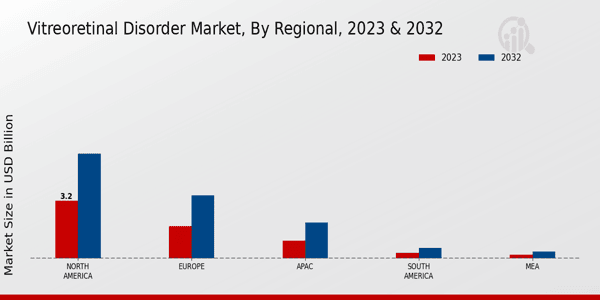Market Growth Projections
The Global Vitreoretinal Disorder Market Industry is projected to experience substantial growth over the next decade. In 2024, the market is valued at 7.5 USD Billion, with expectations to reach 16.3 USD Billion by 2035. This growth trajectory indicates a compound annual growth rate of 7.33% from 2025 to 2035. Factors contributing to this growth include advancements in treatment technologies, increasing prevalence of vitreoretinal disorders, and rising healthcare expenditure. The market's expansion reflects a broader trend towards prioritizing eye health and investing in innovative solutions to address the challenges posed by these disorders.
Rising Healthcare Expenditure
Increased healthcare expenditure across various regions is a pivotal driver for the Global Vitreoretinal Disorder Market Industry. Governments and private sectors are allocating more resources to healthcare, which facilitates access to advanced diagnostic and therapeutic options for vitreoretinal disorders. For instance, in 2024, the market is anticipated to reach 7.5 USD Billion, reflecting the growing financial commitment to eye care. This trend is expected to continue, with projections indicating a market value of 16.3 USD Billion by 2035, suggesting a robust compound annual growth rate of 7.33% from 2025 to 2035.
Advancements in Treatment Technologies
Technological innovations in the treatment of vitreoretinal disorders are significantly influencing the Global Vitreoretinal Disorder Market Industry. The development of minimally invasive surgical techniques, such as vitrectomy and retinal laser therapies, has improved patient outcomes and reduced recovery times. Furthermore, the introduction of novel pharmacological agents, including anti-VEGF therapies, has revolutionized the management of conditions like wet age-related macular degeneration. These advancements not only enhance the effectiveness of treatments but also expand the therapeutic options available, thereby attracting investments and driving market growth.
Emerging Markets and Demographic Shifts
Emerging markets are becoming increasingly significant in the Global Vitreoretinal Disorder Market Industry due to demographic shifts and rising disposable incomes. Countries in Asia-Pacific and Latin America are witnessing a surge in the aging population, which correlates with a higher incidence of vitreoretinal disorders. As these regions invest in healthcare infrastructure and improve access to eye care services, the market is expected to expand. The combination of demographic changes and economic growth creates a favorable environment for the introduction of new treatments and technologies, thereby enhancing market dynamics.
Growing Awareness and Screening Programs
The Global Vitreoretinal Disorder Market Industry is benefiting from increased awareness and proactive screening programs aimed at early detection of vitreoretinal disorders. Health organizations and advocacy groups are promoting regular eye examinations, particularly for high-risk populations, such as diabetics and the elderly. These initiatives are crucial in identifying conditions like diabetic retinopathy at earlier stages, which can lead to more effective treatment outcomes. As awareness continues to grow, the demand for screening technologies and subsequent treatment options is likely to rise, further propelling market growth.
Increasing Prevalence of Vitreoretinal Disorders
The Global Vitreoretinal Disorder Market Industry is experiencing growth driven by the rising incidence of vitreoretinal disorders, such as diabetic retinopathy and age-related macular degeneration. According to health statistics, the prevalence of diabetic retinopathy is projected to reach approximately 191 million cases globally by 2030. This surge in cases necessitates advanced treatment options, thereby propelling market expansion. As the population ages and lifestyle-related factors contribute to these disorders, the demand for innovative therapies and surgical interventions is likely to increase, further stimulating the market's growth.





















Leave a Comment